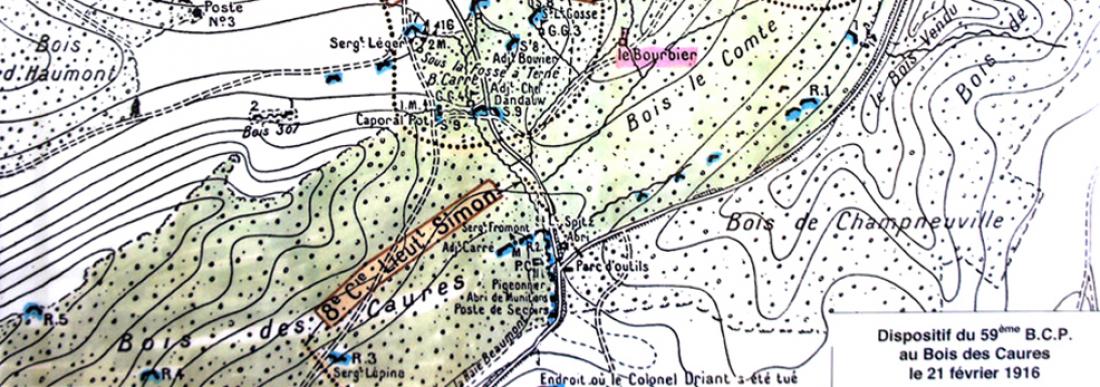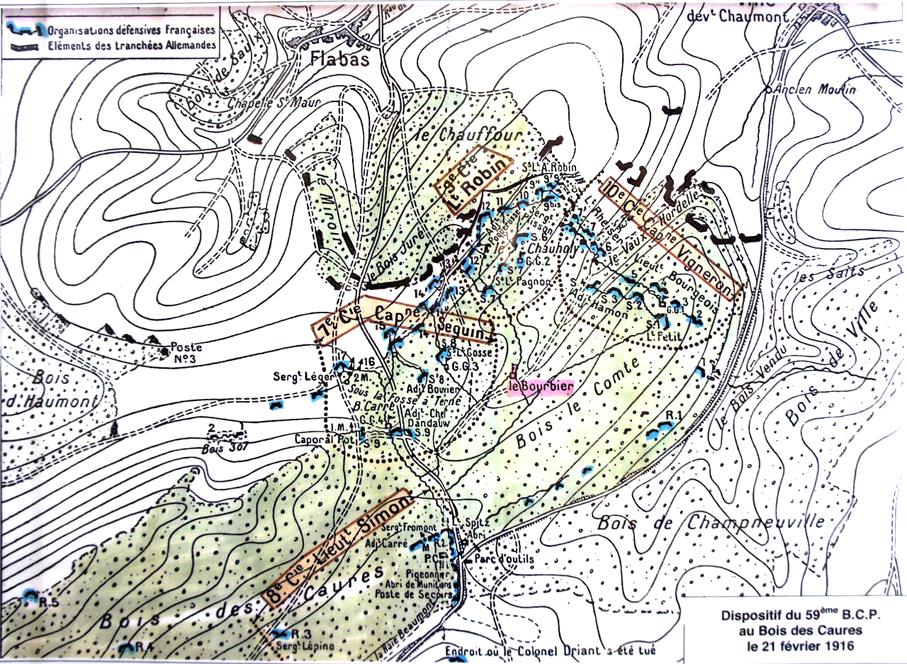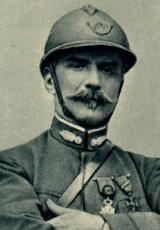The Battle of Bois des Caures

On 20 February, Driant wrote in one of his final letters: ”On General Bapst's order... the visit by Joffre yesterday proves that the time is nigh and, deep down, I feel a satisfaction to know that my predictions of a month ago were right… their attack may happen tonight or in several days' time, but it is certain.”
Strategic location
The Bois des Caures is a slightly elevated wood stretching southwest to northwest. Three kilometres long and 800 metres wide, to the north it overlooked the front line, beyond which lay the towns of Flabas and Ville-devant-Chaumont. It is towards this point that two branches of the road running from Verdun and passing though Vacherauville and Mormont Farm lead. The fork, situated in the wood is an important point on the terrain. Bois des Caures is surrounded in the west by Bois d'Haumont and to the east by Bois de Ville and l'Herbebois.
Tactical organisation
The woods were composed of three positions staggered at different depths. At the northern edge was the line of the ”grands gardes”, a collection of isolated trenches covered by a continuous mesh of barbed wire. Further to the rear, in the woods, was the main resistance line. This consisted of small cage structures designated by the letter S followed by a number. The fallback line completed the plan. The colonel's outpost was a concrete shelter close to the junction and structure RE.
Bois des Caures in the confrontations of 1916
On 21 February, the Bois des Caures was the turning point of two divisions of the 30th Army Corps under General Chrétien. In the west, the 72nd infantry division under General Bapst occupied the area that extended from Meuse to the road to Ville. His right-hand brigade (143rd, Colonel Vaulet) had two battalions (of the 165th and 362nd infantry regiments) in the Bois d'Haumont and the Driant group in the Bois des Caures. To the east, the 51st infantry division was on the line between the road to Ville and the area near Bois de Maucourt. His left-hand brigade (General Rogerie) has a battalion (of the 164th infantry regiment) in the Bois de Ville, and a reinforced battalion (164th infantry regiments and two companies of the 243rd infantry regiments) in Herbebois.
The German army in 1916
The German formation comprised three army corps : To the west, the 7th reserve corps were in charge of taking the Bois d'Haumont; in the centre, the 18th corps was put in charge of the Bois des Caures; to the east, the 3rd corps was to attack the Bois de Ville et l'Herbebois, then push towards Douaumont.
Click on the map to zoom in
The combats
It was Germany's 21st infantry division, the first rung of the 18th corps, that confronted the hunters squad. Its four regiments totalled between 8,000 and 10,000 men. The French, with reinforcements from the 165th infantry regiment, totalled around 1,200. Along 12 kilometres of the front line in the main area of attack, 270 French cannons provided support. Half were modern 75mm tank guns, but the others were slow-firing heavy artillery (de Bange models) impossible to move about. The enemy were armed with 850 well-adapted German pieces, including 540 heavy artillery. And provisions in terms of munitions were proportionate. At daybreak on 21 February, the 59th was at the front line, under the orders of Commander Renouard. The 56th, with Captain Vincent, was in reserve at Mormont Farm. Colonel Driant on reconnaissance in the woods saw the bombardment and decided to remain at the advanced outpost close to structure R2. Doctor Baudru and Father de Martimprey were also busy there as it was also the first-aid post. In the morning, a direct hit destroyed the room serving as the Colonel's office and killed his secretary, Lieutenant Petitcollot, who was working there. The bombardment stopped at 4 pm, signalling the start of the infantry attack.
The Bois de Caures was attached at its northern border, but it was also overwhelmed by points infiltrated the length of Bois d'Haumont. Troops penetrated into Bois de Ville and Herbebois. The weight of this initial attack was mainly supported by Seguin's and Robin's companies, confronting the enemy in the northwest. Fighting was particularly fierce at trench 16, were Sergeant Legrand and six hunters were based, and shelter 17, defended by Sergeant Legrand and five men. The hunters lost a section of the front line, but held the section held by the right-hand ”great guard” of the 59th. A confused and violent battle was waged in the wood: S7, S'7 and the trench, 12 and 12' were lost and then recaptured by bayonet fighting at the start of the night under the command of Lieutenant Robin. A lull had set in by 10.30 pm. The western side of the wood, north of the fallback line, was still patrolled by Allied troops. The 56th, arriving in the evening as reinforcements, made up for losses incurred by the 59th and by the 165th infantry regiment in the ravine of Bous d'Haumont. The next day, the bombardment resumed and lasted the entire morning.
At midday, the attack was launched while it snowed. The German 6th infantry division failed at Herbebois, but the 5th infantry division took the Bois de Ville. The Bois de Caures, overwhelmed in the east, was also threatened at its western flank, where loads of soldiers from a regiment emerged from the Bois du Miroir and rushed into the ravine in the Bois d'Haumont. The three companies in the front line were overtaken by two regiments and overwhelmed and reduce by two battalions left behind for this very purpose. Seguin's company retreated to S7 and S8 and were killed during grenade fighting. Robin's company suffered the same fate. Sergeant Avet (56th) managed to hide in trench 12 and then took nine hours to reach the French lines, the following night. In the northeast, Vigneron's company, attacked and surrounded by two battalions, was also brought down. German Army Pioneers used flamethrowers to burn the abatis fortification. The resistance focused on the fallback line: at R2, the position of Driant and 120 hunters; at R3, the position of Sergeant Lépine's half-section, and at R4 and R5 held by the Quaegebeur company, which joined forces with the 165th infantry regiments.
Around 3 pm, an enemy regiment took R3 and cut off the central hub where Driant and 80 survivors remained. The colonel fired at the enemy in the kneeling position with a chest of grenades close to hand: his last resort when his weapon ran out of ammunition. With shrapnel also exploding over them, the Germans, who were greater in number, came even closer. A group of machine gunners realised a 77 was firing on the Route de Ville and took the rear position, but the position soon became untenable due to the strength of German fire. Anglemont Farm was occupied, the Germans infiltrating as far as Joli-Coeur, south of the wood along whose border infantrymen were lined. The officers decided to retreat towards Beaumont. Simon's company stayed last to provide cover, its rear guard, the Spitz section, being annihilated in a matter of seconds.
Final hours
Colonel Driant took his time and stopped a moment at the first-aid post and then a little further to tend to hunter Papin's wounds. Coming to the edge of a shell hole, where Sergeants Hacquin and Cosine were hiding before they carried on their way, he turned on the spot and, having been shot in the head, fell facing the wood. Digging the earth with their hands, the two non-commissioned officers climbed up to him but quickly realised they were too late. Very quickly, the Germans arrived and took the men prisoner. In the absence of the only two witnesses, the uncertainty of the colonel's exact fate lasted for several weeks. In the evening, a dozen officers and around 110 hunters assembled in Vacherauville.
The legend of Bois des Caures
Very quickly, the legend of Driant's hunters spread. The popular sentiment was freely expressed in songs, of which many were inspired by the Great War. Such as that composed by Breton bard Théodore Botrel which ends with this verse: ”Repose, calme et confiant ; La terre où tu dors - ô Driant !- Va, ne sera plus dans un an Terre allemande !.... Tes petits chasseurs -tes enfants-Tés vengeurs, demi-triomphants, Avec toi mort, entrent, vivants, Dans la légende !”
”Lay, calm and confident; the land where you sleep - oh Driant - fear not, will no longer be German soil in a year from now.
Your little hunters, your children, your avengers, half-triumphant, dead with you, enter living into legend!”



